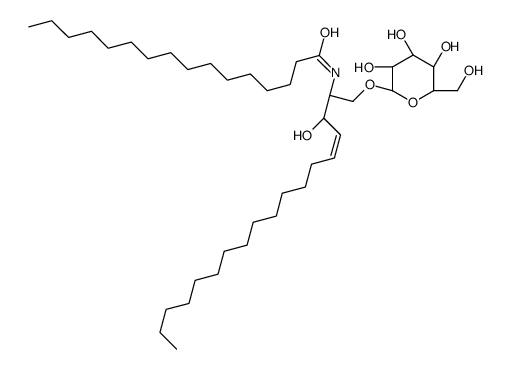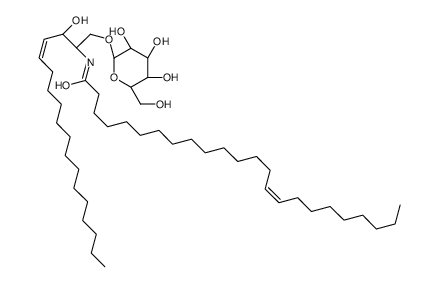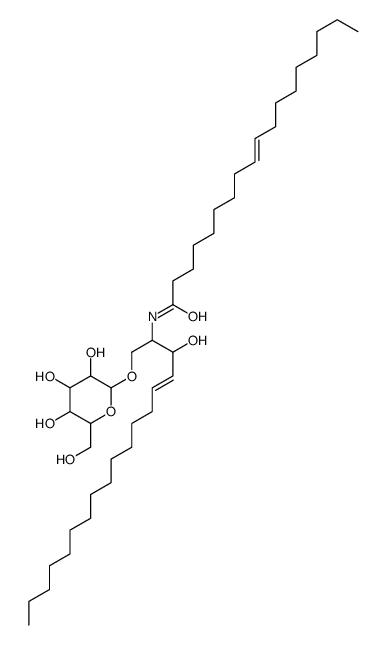This product was successfully added to cart!
品牌商品推荐
更多 >>商品详情
客户评价
| 描述 |
精神碱(半乳糖基鞘氨醇)是半乳糖苷酶(GALC)的底物,是克拉贝病的潜在生物标志物[1]。精神碱是一种具有高度细胞毒性的脂质,能够诱导多种细胞类型的细胞死亡,包括与球细胞白质营养不良(GLD)最相关的少突胶质细胞。精神药物至少部分通过细胞凋亡导致细胞死亡。精神药物也是PKC的抑制剂[1]。 |
|---|---|
| 相关类别 |
|
| 靶点 |
PKC
|
| 体外研究 |
精神药物是GALC酶的底物,有望帮助诊断和随访通过新生儿筛查(NBS)确定的高危婴儿[1]。精神药物可诱导多效性效应,包括多种细胞途径的功能障碍[2]。细胞活力测定[2]细胞系:少突胶质细胞,M03。13浓度:10、20和40μM培养时间:24小时结果:至少部分通过凋亡导致细胞死亡。 |
| 存储 |
请将产品存放在分析证书中的建议条件下。
|
| 运输 |
室温 |
| 参考文献 |
|
| 密度 | 1.14 g/cm3 |
|---|---|
| 沸点 | 664.3?C |
| 分子式 | C24H47NO7 |
| 分子量 | 461.63200 |
| 闪点 | 355.6?C |
| 精确质量 | 461.33500 |
| PSA | 145.63000 |
| LogP | 2.44870 |
| 外观性状 | 白色粉末 |
| 蒸汽压 | 1.77E-20mmHg at 25°C |
| 折射率 | 1.535 |
| 储存条件 |
-20°C储存 |
| 分子结构 |
1、 摩尔折射率:125.67 2、 摩尔体积(m3/mol):403.3 3、 等张比容(90.2K):1090.8 4、 表面张力(dyne/cm):53.4 5、 极化率(10 -24cm 3):49.82 |
| 计算化学 |
1、 疏水参数计算参考值(XlogP):3.7 2、 氢键供体数量:6 3、 氢键受体数量:8 4、 可旋转化学键数量:18 5、 互变异构体数量: 6、 拓扑分子极性表面积(TPSA):146 7、 重原子数量:32 8、 表面电荷:0 9、 复杂度:479 10、同位素原子数量:0 11、确定原子立构中心数量:5 12、不确定原子立构中心数量:2 13、确定化学键立构中心数量:1 14、不确定化学键立构中心数量:0 15、共价键单元数量:1 |
| 更多 |
1. 性状:未确定 2. 密度(g/mL,20?C):未确定 3. 相对蒸汽密度(g/mL,空气=1):未确定 4. 熔点(?C):未确定 5. 沸点(?C,常压):未确定 6. 沸点(?C 20mmHg):未确定 7. 折射率(nD20):未确定 8. 闪点(?C):未确定 9. 比旋光度():未确定 10. 自燃点或引燃温度(?C):未确定 11. 蒸气压(Pa,25?C):未确定 12. 饱和蒸气压(kPa,20?C):未确定 13. 燃烧热(KJ/mol):未确定 14. 临界温度(?C):未确定 15. 临界压力(KPa):未确定 16. 油水(辛醇/水)分配系数的对数值:未确定 17. 爆炸上限(%,V/V):未确定 18. 爆炸下限(%,V/V):未确定 19. 溶解性:未确定 |
| 符号 |

GHS07 |
|---|---|
| 信号词 |
Warning |
| 危害声明 |
H302-H312-H332 |
| 警示性声明 |
P280 |
| 个人防护装备 |
dust mask type N95 (US);Eyeshields;Gloves |
| 危害码 (欧洲) |
Xn: Harmful; |
| 风险声明 (欧洲) |
R20/21/22 |
| 安全声明 (欧洲) |
36 |
| 危险品运输编码 | NONH for all modes of transport |
| 神经鞘氨醇半乳糖苷上游产品? 0 | |
|---|---|
| 神经鞘氨醇半乳糖苷下游产品? 3 | |
|
|
|
|
How well does urinary lyso-Gb3 function as a biomarker in Fabry disease? Clin. Chim. Acta 411(23-24) , 1906-14, (2010)
Fabry disease is characterized by accumulation of glycosphingolipids, such as globotriaosylceramide (Gb(3)), in many tissues and body fluids. A novel plasma biomarker, globotriaosylsphingosine (lyso-G…
|
|
|
Aberrant production of tenascin-C in globoid cell leukodystrophy alters psychosine-induced microglial functions. J. Neuropathol. Exp. Neurol. 73(10) , 964-74, (2014)
Globoid cell leukodystrophy (GLD), or Krabbe disease, is a rare and often fatal demyelinating disease caused by mutations in the galactocerebrosidase (galc) gene that result in accumulation of galacto…
|
|
|
Bone marrow transplantation augments the effect of brain- and spinal cord-directed adeno-associated virus 2/5 gene therapy by altering inflammation in the murine model of globoid-cell leukodystrophy. J. Neurosci. 31(27) , 9945-57, (2011)
Globoid-cell leukodystrophy (GLD) is an inherited demyelinating disease caused by the deficiency of the lysosomal enzyme galactosylceramidase (GALC). A previous study in the murine model of GLD (twitc…
|
|
|
Galactosylsphingosine |
|
D-galactosyl-?1-1′-D-erythro-sphingosine |
|
1-B-D-GALACTOSYLSPHINOGOSINE |
|
Psychosine from bovine brain |
|
PSYCHOSIN |
|
PSYCHOSINE |
|
D-GALACTOSYL-B1-1′ SPHINGOSN |
|
LYSO-CERAMIDEGALACTOSIDE |
|
MFCD00057505 |
|
O-Galactosylsphingosine |
|
LYSO-CEREBROSIDE |

















